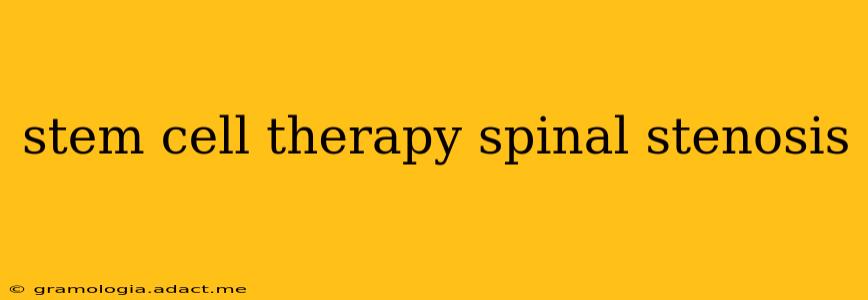Spinal stenosis, a narrowing of the spinal canal that puts pressure on the spinal cord and nerves, can cause debilitating pain and loss of function. While traditional treatments like surgery and medication exist, stem cell therapy offers a promising, minimally invasive alternative for some patients. This comprehensive guide explores the potential benefits, risks, and considerations surrounding stem cell therapy for spinal stenosis.
What is Spinal Stenosis?
Spinal stenosis is a condition characterized by the narrowing of the spaces within your spine. This narrowing can compress the spinal cord and nerves, leading to a variety of symptoms, including pain, numbness, tingling, weakness, and difficulty walking. Several factors contribute to spinal stenosis, including age-related wear and tear (degenerative stenosis), bone spurs (osteophytes), herniated discs, and spinal injuries. The location of the stenosis (cervical, thoracic, or lumbar spine) impacts the specific symptoms experienced.
What is Stem Cell Therapy?
Stem cell therapy harnesses the body's natural regenerative capabilities. Stem cells are undifferentiated cells that can develop into various specialized cell types. In the context of spinal stenosis, stem cells are introduced into the affected area of the spine, with the aim of:
- Reducing inflammation: Stem cells produce anti-inflammatory molecules that can alleviate pain and swelling.
- Repairing damaged tissue: Stem cells can differentiate into cartilage, bone, and other tissues, potentially repairing damaged discs or other structures contributing to stenosis.
- Stimulating nerve regeneration: Stem cells may promote the growth and repair of damaged nerves, improving nerve function and reducing symptoms.
How Does Stem Cell Therapy Work for Spinal Stenosis?
The exact mechanisms through which stem cells alleviate spinal stenosis symptoms are still under investigation. However, current research suggests that the therapeutic effects are multifactorial, involving the reduction of inflammation, the stimulation of tissue regeneration, and the modulation of the immune system. The procedure itself is minimally invasive, often involving injections guided by imaging techniques.
Is Stem Cell Therapy Effective for Spinal Stenosis?
While research on stem cell therapy for spinal stenosis is ongoing and results are promising, it's crucial to understand that it's not a guaranteed cure. The effectiveness of the therapy varies depending on several factors, including the severity of the stenosis, the patient's overall health, and the type of stem cells used. Studies have shown positive outcomes in terms of pain reduction and improved function for some patients, but more large-scale, long-term studies are needed to confirm these findings and establish clear guidelines for its application.
What are the Risks and Side Effects of Stem Cell Therapy for Spinal Stenosis?
As with any medical procedure, stem cell therapy carries potential risks and side effects. These may include:
- Pain at the injection site: This is a common and usually temporary side effect.
- Infection: The risk of infection is relatively low but can be serious.
- Bleeding or bruising: These are also relatively common and usually minor.
- Allergic reactions: Allergic reactions to the injected materials are possible, although rare.
- Unintended effects: While rare, there’s a potential for unintended effects due to the introduction of stem cells.
It's vital to discuss these risks and potential side effects with your doctor before undergoing the procedure.
What are the Different Types of Stem Cells Used in Spinal Stenosis Treatment?
Several types of stem cells can be used, including:
- Mesenchymal stem cells (MSCs): These are commonly used and derived from various sources, including bone marrow and adipose tissue (fat).
- Autologous stem cells: These are derived from the patient's own body, minimizing the risk of rejection.
- Allogeneic stem cells: These are derived from a donor and may carry a slightly higher risk of rejection.
Is Stem Cell Therapy for Spinal Stenosis Covered by Insurance?
Insurance coverage for stem cell therapy for spinal stenosis varies widely depending on the insurance provider, the type of stem cells used, and the specific circumstances. It's essential to contact your insurance company directly to determine your coverage before proceeding with treatment.
What are the Alternatives to Stem Cell Therapy for Spinal Stenosis?
Several alternative treatments exist for spinal stenosis, including:
- Medications: Pain relievers, anti-inflammatory drugs, and muscle relaxants can help manage symptoms.
- Physical therapy: Exercises and physical therapy can help improve strength, flexibility, and mobility.
- Epidural steroid injections: These injections can help reduce inflammation and pain.
- Surgery: In severe cases, surgery may be necessary to decompress the spinal cord and nerves.
How Do I Find a Qualified Doctor for Stem Cell Therapy?
Finding a qualified and experienced physician is crucial. Look for doctors with expertise in interventional pain management and a strong understanding of stem cell therapy. Ensure the clinic adheres to strict safety and regulatory standards.
This information is intended for educational purposes only and should not be considered medical advice. Always consult with your healthcare provider to discuss your specific condition and determine the most appropriate treatment plan for you. The field of stem cell therapy is constantly evolving, and further research is needed to fully understand its long-term efficacy and safety for spinal stenosis.
